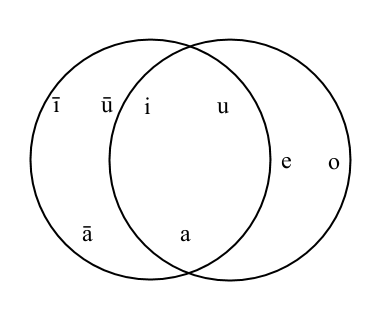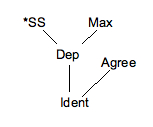|
Bleeding Order
Bleeding order is a term used in phonology to describe specific interactions of phonological rules. The term was introduced in 1968 by Paul Kiparsky. If two phonological rules are said to be in bleeding order, the application of the first rule creates a context in which the second rule can no longer apply. The opposite of this is called feeding order. Examples An example of this in English is the -insertion between a voiceless alveolar fricative and a plural-''z'', as in (with the underlying representation ). English also has a rule which devoices segments after voiceless consonants, as in , with the underlying representation ). In the output form (''buses''), final devoicing has not applied, because the phonological context in which this rule could have applied has gone as a consequence of the application of -insertion. Put differently, the application order "(1) -insertion (2) final devoicing" is a bleeding order in English. Counterbleeding order If two rules which ''wou ... [...More Info...] [...Related Items...] OR: [Wikipedia] [Google] [Baidu] |
Phonology
Phonology is the branch of linguistics that studies how languages or dialects systematically organize their sounds or, for sign languages, their constituent parts of signs. The term can also refer specifically to the sound or sign system of a particular language variety. At one time, the study of phonology related only to the study of the systems of phonemes in spoken languages, but may now relate to any linguistic analysis either: Sign languages have a phonological system equivalent to the system of sounds in spoken languages. The building blocks of signs are specifications for movement, location, and handshape. At first, a separate terminology was used for the study of sign phonology ('chereme' instead of 'phoneme', etc.), but the concepts are now considered to apply universally to all human languages. Terminology The word 'phonology' (as in 'phonology of English') can refer either to the field of study or to the phonological system of a given language. This is one of th ... [...More Info...] [...Related Items...] OR: [Wikipedia] [Google] [Baidu] |
Dutch Language
Dutch ( ) is a West Germanic language spoken by about 25 million people as a first language and 5 million as a second language. It is the third most widely spoken Germanic language, after its close relatives German and English. ''Afrikaans'' is a separate but somewhat mutually intelligible daughter languageAfrikaans is a daughter language of Dutch; see , , , , , . Afrikaans was historically called Cape Dutch; see , , , , , . Afrikaans is rooted in 17th-century dialects of Dutch; see , , , . Afrikaans is variously described as a creole, a partially creolised language, or a deviant variety of Dutch; see . spoken, to some degree, by at least 16 million people, mainly in South Africa and Namibia, evolving from the Cape Dutch dialects of Southern Africa. The dialects used in Belgium (including Flemish) and in Suriname, meanwhile, are all guided by the Dutch Language Union. In Europe, most of the population of the Netherlands (where it is the only official language spoken country ... [...More Info...] [...Related Items...] OR: [Wikipedia] [Google] [Baidu] |
Phonology
Phonology is the branch of linguistics that studies how languages or dialects systematically organize their sounds or, for sign languages, their constituent parts of signs. The term can also refer specifically to the sound or sign system of a particular language variety. At one time, the study of phonology related only to the study of the systems of phonemes in spoken languages, but may now relate to any linguistic analysis either: Sign languages have a phonological system equivalent to the system of sounds in spoken languages. The building blocks of signs are specifications for movement, location, and handshape. At first, a separate terminology was used for the study of sign phonology ('chereme' instead of 'phoneme', etc.), but the concepts are now considered to apply universally to all human languages. Terminology The word 'phonology' (as in 'phonology of English') can refer either to the field of study or to the phonological system of a given language. This is one of th ... [...More Info...] [...Related Items...] OR: [Wikipedia] [Google] [Baidu] |
Phonological Opacity
Phonological opacity is a term used in phonology. It was first defined by Kiparsky as a measure of the context or the consequences of a phonological process that may be determined only by examining the surface structure. Kiparsky defined it in the following way: A phonological rule ''P'', A \rightarrow B / C \underline D, is opaque only if all of the following surface structures exist: * instance of ''A'' in the C \underline D environment; * instance of ''B'' created by ''P'' in an environment other than C \underline D; * instance of ''B'' not derived from ''P'' that occur in the context C \underline D. A common example is the interaction of the flapping of // and the raising of // in Canadian English and other dialects. Before voiceless consonants such as [], the diphthong // is raised to sound more like [], so the word ''write'' is pronounced []. In some contexts between vowels, // is replaced by the (voiced) flap [], so (for example) ''patting'' is pronounced [], similar to ... [...More Info...] [...Related Items...] OR: [Wikipedia] [Google] [Baidu] |
Optimality Theory
In linguistics, Optimality Theory (frequently abbreviated OT) is a linguistic model proposing that the observed forms of language arise from the optimal satisfaction of conflicting constraints. OT differs from other approaches to phonological analysis, such as autosegmental phonology and linear phonology (SPE), which typically use rules rather than constraints. OT models grammars as systems that provide mappings from inputs to outputs; typically, the inputs are conceived of as underlying representations, and the outputs as their surface realizations. It is an approach within the larger framework of generative grammar. In linguistics, Optimality Theory has its origin in a talk given by Alan Prince and Paul Smolensky in 1991 which was later developed in a book manuscript by the same authors in 1993. Overview There are three basic components of the theory: * Generator () takes an input, and generates the list of possible outputs, or candidates, * Constraint component () provides ... [...More Info...] [...Related Items...] OR: [Wikipedia] [Google] [Baidu] |
Markedness
In linguistics and social sciences, markedness is the state of standing out as nontypical or divergent as opposed to regular or common. In a marked–unmarked relation, one term of an opposition is the broader, dominant one. The dominant default or minimum-effort form is known as ''unmarked''; the other, secondary one is ''marked''. In other words, markedness involves the characterization of a "normal" linguistic unit against one or more of its possible "irregular" forms. In linguistics, markedness can apply to, among others, Phonology, phonological, Grammar, grammatical, and Semantics, semantic oppositions, defining them in terms of marked and unmarked oppositions, such as ''honest'' (unmarked) vs. ''dishonest'' (marked). Marking may be purely semantic, or may be realized as extra morphology. The term derives from the marking of a grammatical role with a suffix or another element, and has been extended to situations where there is no morphological distinction. In social scien ... [...More Info...] [...Related Items...] OR: [Wikipedia] [Google] [Baidu] |
Feeding Order
In phonology and historical linguistics, feeding order is a situation in which rule A creates new contexts in which rule B can apply; it would not have been possible for rule B to apply otherwise. If there are two rules, rule A which looks like ''x → y'' and rule B which looks like ''y → z'', then the following is a feeding order: # A: ''x→y'' # B: ''y→z'' The opposite of feeding order, the situation in which rule A destroys a certain context so rule B can no longer apply, is called ''bleeding order''. Examples A good example of feeding order can be seen in English, where preglottalization can be considered as rule B. As a consequence of this rule, all voiceless plosives which make part of a word-final consonant cluster are glottalized. This can be seen in the form ''looked'', with the underlying representation . It is pronounced . Another rule in English which is called fortis stop insertion shall be considered here as rule A. This rule inserts a voiceless plosive for ... [...More Info...] [...Related Items...] OR: [Wikipedia] [Google] [Baidu] |
Suffix
In linguistics, a suffix is an affix which is placed after the stem of a word. Common examples are case endings, which indicate the grammatical case of nouns, adjectives, and verb endings, which form the conjugation of verbs. Suffixes can carry grammatical information (inflectional suffixes) or lexical information ( derivational/lexical suffixes'').'' An inflectional suffix or a grammatical suffix. Such inflection changes the grammatical properties of a word within its syntactic category. For derivational suffixes, they can be divided into two categories: class-changing derivation and class-maintaining derivation. Particularly in the study of Semitic languages, suffixes are called affirmatives, as they can alter the form of the words. In Indo-European studies, a distinction is made between suffixes and endings (see Proto-Indo-European root). Suffixes can carry grammatical information or lexical information. A word-final segment that is somewhere between a free morpheme and a b ... [...More Info...] [...Related Items...] OR: [Wikipedia] [Google] [Baidu] |
Noun Stem
A noun () is a word that generally functions as the name of a specific object or set of objects, such as living creatures, places, actions, qualities, states of existence, or ideas.Example nouns for: * Living creatures (including people, alive, dead or imaginary): ''mushrooms, dogs, Afro-Caribbeans, rosebushes, Nelson Mandela, bacteria, Klingons'', etc. * Physical objects: ''hammers, pencils, Earth, guitars, atoms, stones, boots, shadows'', etc. * Places: ''closets, temples, rivers, Antarctica, houses, Grand Canyon, utopia'', etc. * Actions: ''swimming, exercises, diffusions, explosions, flight, electrification, embezzlement'', etc. * Qualities: ''colors, lengths, deafness, weights, roundness, symmetry, warp speed,'' etc. * Mental or physical states of existence: ''jealousy, sleep, heat, joy, stomachache, confusion, mind meld,'' etc. Lexical categories (parts of speech) are defined in terms of the ways in which their members combine with other kinds of expressions. The syntact ... [...More Info...] [...Related Items...] OR: [Wikipedia] [Google] [Baidu] |
Kaatsheuvel
Kaatsheuvel () is a town in the province of North Brabant, Netherlands situated along highways N261 and N628. With a population of roughly 16,600, it is the largest town in and the capital of the municipality of Loon op Zand, which also consists of the villages of De Moer and Loon op Zand. As Kaatsheuvel is a municipality capital, it has a town hall, located in the town centre. The town hall was torn down in 2010 as part of an ambitious plan to build a lively new town centre. A new town centre has been built, with the title ''Bruisend Dorpshart'' (Sparkling Village's Heart). Kaatsheuvel is internationally known for the Efteling theme park and as a gateway to National Park Loonse en Drunense Duinen. History 13th and 14th century: Duke of Brabant and Lord of Venloon The Netherlands traditionally consisted of seven provinces. The current province of North Brabant, in which Kaatsheuvel is located, used to be a stand-alone Duchy. The Duchy consisted of a large area with the most i ... [...More Info...] [...Related Items...] OR: [Wikipedia] [Google] [Baidu] |
Diminutive
A diminutive is a root word that has been modified to convey a slighter degree of its root meaning, either to convey the smallness of the object or quality named, or to convey a sense of intimacy or endearment. A (abbreviated ) is a word-formation device used to express such meanings. In many languages, such forms can be translated as "little" and diminutives can also be formed as multi-word constructions such as " Tiny Tim". Diminutives are often employed as nicknames and pet names when speaking to small children and when expressing extreme tenderness and intimacy to an adult. The opposite of the diminutive form is the augmentative. Beyond the ''diminutive form'' of a single word, a ''diminutive'' can be a multi-word name, such as "Tiny Tim" or "Little Dorrit". In many languages, formation of diminutives by adding suffixes is a productive part of the language. For example, in Spanish can be a nickname for someone who is overweight, and by adding an suffix, it becomes which ... [...More Info...] [...Related Items...] OR: [Wikipedia] [Google] [Baidu] |
Paul Kiparsky
René Paul Victor Kiparsky (born January 28, 1941) is a Finnish professor of linguistics at Stanford University. He is the son of the Russian-born linguist and Slavicist Valentin Kiparsky. Kiparsky is especially known for his contributions to phonology. These include coining the terms elsewhere principle, and phonological opacity (including the types feeding, bleeding, counterfeeding, and counterbleeding), and creating the frameworks of Lexical Phonology and Morphology (LPM) and its successor, Stratal Optimality Theory. A noted Pāṇini scholar, he has also made fundamental contributions to historical linguistics and generative metrics, as well as working in morphosyntax, especially on his native Finnish. Academic life Kiparsky was born in Helsinki. He studied at Alabama College (now the University of Montevallo), the University of Helsinki and the University of Minnesota. Kiparsky was a student of Morris Halle at MIT, where he received his PhD in 1965. For two decades, from ... [...More Info...] [...Related Items...] OR: [Wikipedia] [Google] [Baidu] |



